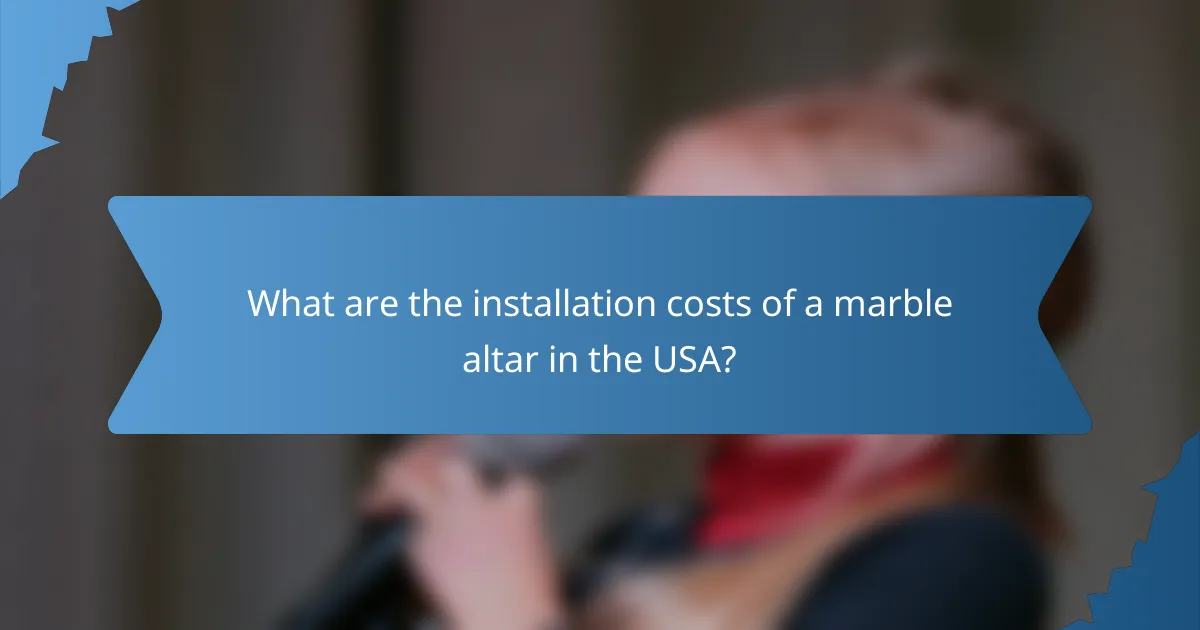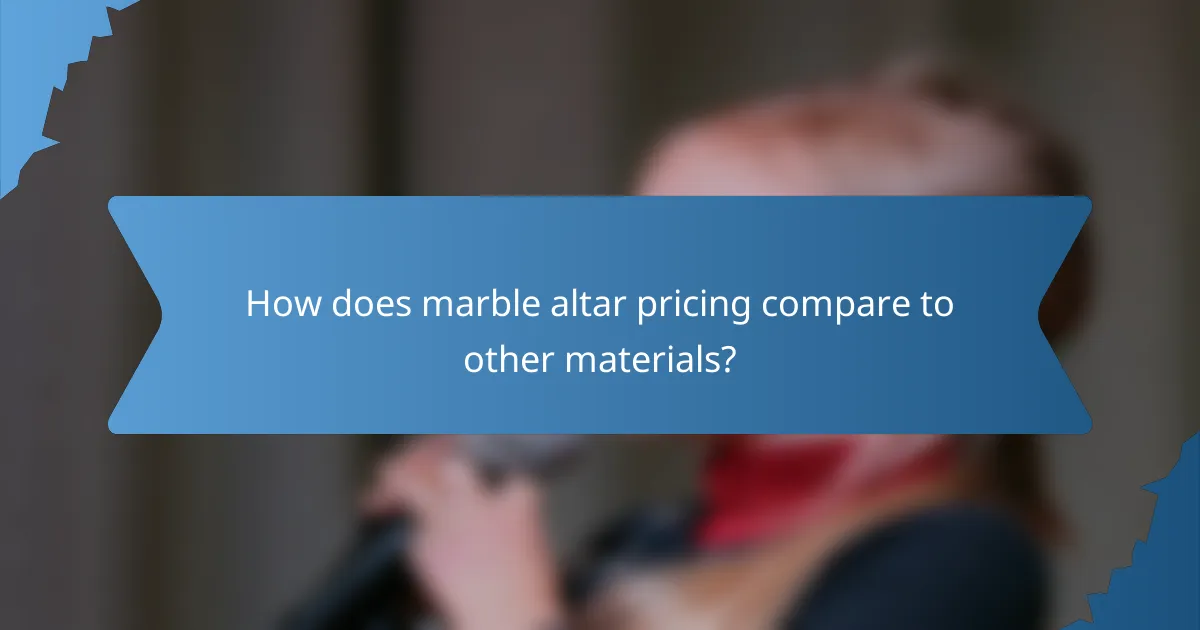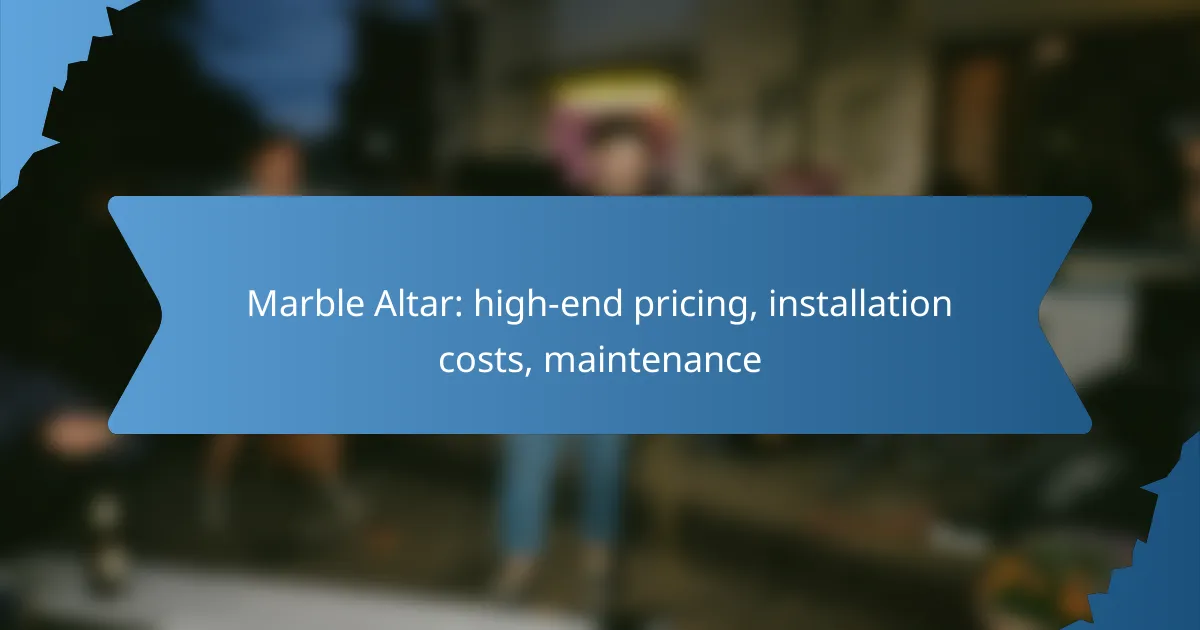Investing in a marble altar can be a significant financial commitment, with high-end options ranging from several thousand to tens of thousands of dollars based on size, design, and marble quality. Installation costs also vary widely, influenced by materials, labor, and customization. To ensure the altar remains a stunning centerpiece, regular cleaning and careful maintenance are crucial for preserving its beauty and longevity.

What are the installation costs of a marble altar in the USA?
The installation costs of a marble altar in the USA typically range from several thousand to tens of thousands of dollars, depending on various factors. These costs include materials, labor, and any additional features or customizations required for the altar.
Average installation cost range
The average cost for installing a marble altar can vary significantly, generally falling between $5,000 and $15,000. This range encompasses basic installations, while more elaborate designs or larger altars can push costs upwards of $20,000 or more.
When budgeting, consider both the price of the marble itself and the labor required for installation, as skilled craftsmanship is essential for a high-quality finish.
Factors affecting installation costs
Location also plays a role; areas with higher living costs may see increased labor rates. Accessibility to the installation site can further impact costs, especially if heavy lifting equipment is necessary.
Regional cost variations

What is the pricing for high-end marble altars?
High-end marble altars typically range from several thousand to tens of thousands of dollars, depending on factors such as size, design complexity, and the quality of the marble used. Customization and installation can further influence the final cost.
Price range for luxury marble altars
The price for luxury marble altars generally starts at around $5,000 and can exceed $30,000 for larger, intricately designed pieces. Factors such as the type of marble, craftsmanship, and additional features like carvings or inlays can significantly affect the price.
For instance, a simple altar made from standard marble may cost less, while one made from rare stones or featuring custom designs will command a premium. Always consider the total cost, including delivery and installation, when budgeting.
Comparison of brands and styles
When comparing styles, consider traditional versus contemporary designs. Traditional altars may feature ornate carvings and classic shapes, while contemporary options often emphasize minimalism and clean lines. Each style will have different associated costs based on the complexity of the design and the materials used.
Market trends influencing prices
Current market trends show an increasing demand for high-quality, custom marble altars, which can drive prices up. Factors such as the availability of premium marble and the popularity of bespoke designs are influencing pricing structures.
Additionally, economic conditions, including fluctuations in material costs and labor rates, can impact the overall pricing of marble altars. Keeping an eye on these trends can help buyers make informed decisions about their purchases.

How to maintain a marble altar effectively?
To maintain a marble altar effectively, regular cleaning and careful handling are essential. Proper maintenance helps preserve the altar’s appearance and longevity, ensuring it remains a beautiful focal point in any space.
Recommended cleaning products
When cleaning a marble altar, use pH-balanced cleaners specifically designed for natural stone. Avoid acidic or abrasive substances, as they can damage the surface. Some recommended products include mild dish soap mixed with warm water and specialized marble cleaners available at home improvement stores.
For polishing, consider using a stone polish that is safe for marble to enhance its shine and protect against stains. Always test any product on a small, inconspicuous area first to ensure compatibility.
Maintenance frequency guidelines
Regular maintenance of a marble altar typically involves cleaning it weekly to prevent dust and grime buildup. For deeper cleaning, including polishing, aim for every few months, depending on usage and exposure to elements.
Additionally, inspect the altar for any signs of wear or damage at least once a month. Addressing minor issues promptly can prevent more significant problems down the line.
Common maintenance mistakes
One common mistake is using harsh chemicals or abrasive pads, which can scratch or dull the marble surface. Always opt for gentle cleaning methods to preserve the finish.
Another error is neglecting to seal the marble. Depending on the type of marble and its finish, sealing may be necessary every 6 to 12 months to protect against stains and moisture. Failing to seal can lead to permanent damage over time.

What are the benefits of choosing a marble altar?
Choosing a marble altar offers numerous advantages, including exceptional durability, aesthetic appeal, and potential resale value. These benefits make marble a popular choice for both religious and decorative purposes.
Durability and longevity
Marble is known for its strength and resistance to wear, making it an ideal material for altars that are expected to last for many years. With proper care, a marble altar can withstand the test of time, often lasting decades or even centuries without significant deterioration.
However, it is essential to maintain the surface to prevent staining and etching. Regular sealing and cleaning can help preserve its integrity and appearance, ensuring that the altar remains a focal point in any setting.
Aesthetic appeal and customization
The natural beauty of marble provides a timeless elegance that enhances any space. Available in various colors and patterns, marble can be customized to suit specific design preferences, allowing for unique altar designs that reflect personal or cultural significance.
Additionally, intricate carvings and finishes can be added to enhance the altar’s visual impact. This level of customization ensures that each marble altar can be a one-of-a-kind piece, tailored to the needs of the owner.
Resale value considerations
Investing in a marble altar can yield a good resale value due to its enduring popularity and classic appeal. High-quality marble pieces often retain their value well, especially if they are well-maintained and feature unique designs.
When considering resale, factors such as the altar’s condition, craftsmanship, and market demand play crucial roles. Keeping documentation of the altar’s origin and any custom work can also enhance its value in the resale market.

What are the prerequisites for marble altar installation?
Before installing a marble altar, it is essential to ensure proper site preparation and compliance with local regulations. These prerequisites help facilitate a smooth installation process and ensure the altar’s longevity and stability.
Site preparation requirements
Site preparation is crucial for the successful installation of a marble altar. The area must be leveled and cleared of any debris, ensuring a stable foundation. It is advisable to have a concrete or stone base to support the weight of the marble, which can be substantial.
Additionally, consider the accessibility of the site for transporting heavy marble slabs. Ensure that there is enough space for equipment and personnel to work safely. Proper drainage should also be assessed to prevent water accumulation around the altar.
Permitting and regulations
Before proceeding with the installation, check local zoning laws and building codes that may require permits. Some areas may have specific regulations regarding the placement of religious structures, especially in public spaces.
Contact your local municipality or planning department to determine if any permits are needed and to understand any restrictions that may apply. Failing to comply with these regulations can lead to delays or fines, so it is essential to address this early in the planning process.

How does marble altar pricing compare to other materials?
Marble altars typically fall into a higher price range compared to many other materials due to their luxurious appearance and durability. While costs can vary significantly based on quality and design, marble generally commands a premium over alternatives like granite and wood.
Cost comparison with granite altars
Granite altars are often more affordable than marble, with prices usually ranging from moderate to high, depending on the finish and complexity of the design. In contrast, marble altar costs can start from the mid-hundreds and go well into the thousands of dollars, especially for intricate designs.
When considering installation, granite may also have lower labor costs due to its widespread availability and familiarity among contractors. However, marble’s unique aesthetic can justify its higher price for those seeking a distinctive look.
Value analysis against wooden altars
Wooden altars are generally the least expensive option, often costing significantly less than both marble and granite. Prices for wooden altars can start in the low hundreds, making them an attractive choice for budget-conscious buyers.
However, wooden altars require more maintenance and may not offer the same longevity as marble. While marble can last for decades with minimal upkeep, wood is susceptible to wear, moisture, and pests, which can lead to additional costs over time.

What emerging trends are shaping the marble altar market?
The marble altar market is increasingly influenced by sustainability, customization, and technological advancements. These trends are driving demand for eco-friendly materials, personalized designs, and innovative installation techniques.
High-end pricing for marble altars
High-end marble altars typically range from several thousand to tens of thousands of dollars, depending on factors such as size, quality of marble, and craftsmanship. Custom designs and intricate details can significantly increase the price.
When budgeting for a marble altar, consider not only the initial purchase price but also potential costs for delivery and installation. High-quality marble can be more expensive, but it often offers better durability and aesthetic appeal.
Installation costs of marble altars
Installation costs for marble altars can vary widely, generally falling between a few hundred to several thousand dollars. Factors influencing installation costs include the complexity of the design, site preparation, and labor rates in your area.
It’s advisable to obtain multiple quotes from experienced installers to ensure competitive pricing. Ensure that the installer is familiar with handling heavy materials like marble to avoid damage during the process.
Maintenance of marble altars
Maintaining a marble altar involves regular cleaning and periodic sealing to protect against stains and scratches. Use a pH-balanced cleaner and a soft cloth to avoid damaging the surface.
Consider scheduling professional maintenance every few years, especially in high-traffic areas. This can help preserve the altar’s appearance and longevity, ensuring it remains a focal point in your space.
